Following our visit to the Royal Hill of Ambohimanga, my friend Sneža and I headed back by the rented car with driver towards the centre of the capital of Madagascar – Antananarivo.
Keeping in mind the huge traffic jam we had to go through when approaching Ambohimanga, where we were stuck and stood in one place for a long time, Rija, our driver, now decided to take shortcuts. To start with this involved driving over the top of an embankment. But the biggest problem was already encountered at its beginning. Namely, the embankment was fully made of earth and since abundant rain kept falling during the previous days, in the first section there was a large surface with deep and soft mud. Rija is a professional driver and we had a 4x4 vehicle, so there was not too much worry for us, but it was rather disconcerting seeing a car stuck in the mud and a bunch of people trying to push it out of it.
It was all happening rather quickly and certainly completely unexpectedly, while seeming rather unsettling, so I was not ready and did not film the scene. And then we passed by that section and kept driving sporadically through rather deep holes filled with mud.
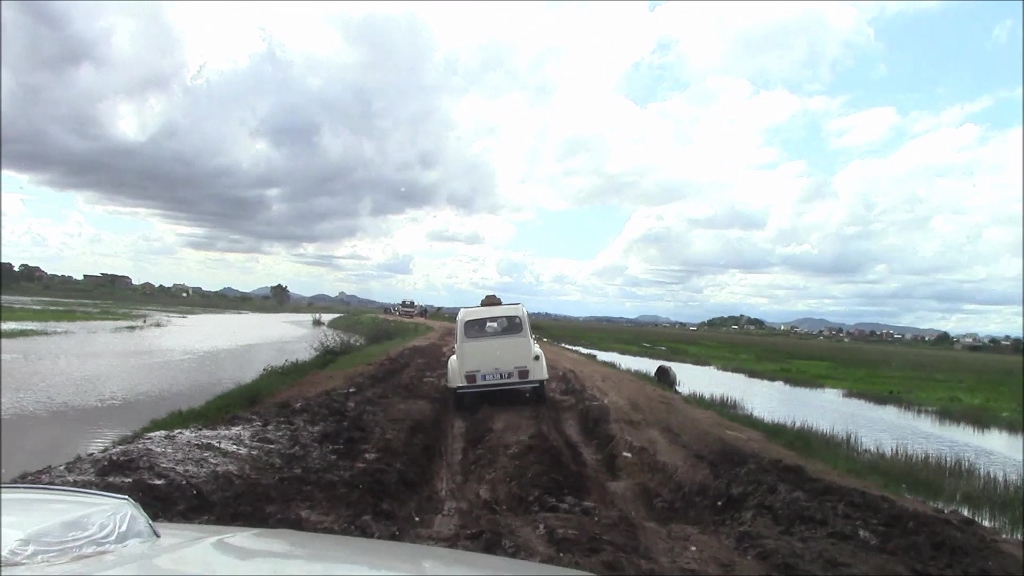 Take my word for it, the worst is behind us
Take my word for it, the worst is behind us
Bearing in mind how much our car jumped up and down and how much Rija tried to aim the right tracks for our wheels, I wondered how the car in front of us, without being a 4x4, managed to pass here. Apparently – quite successfully.
Very soon we got to a completely dry section of the embankment.
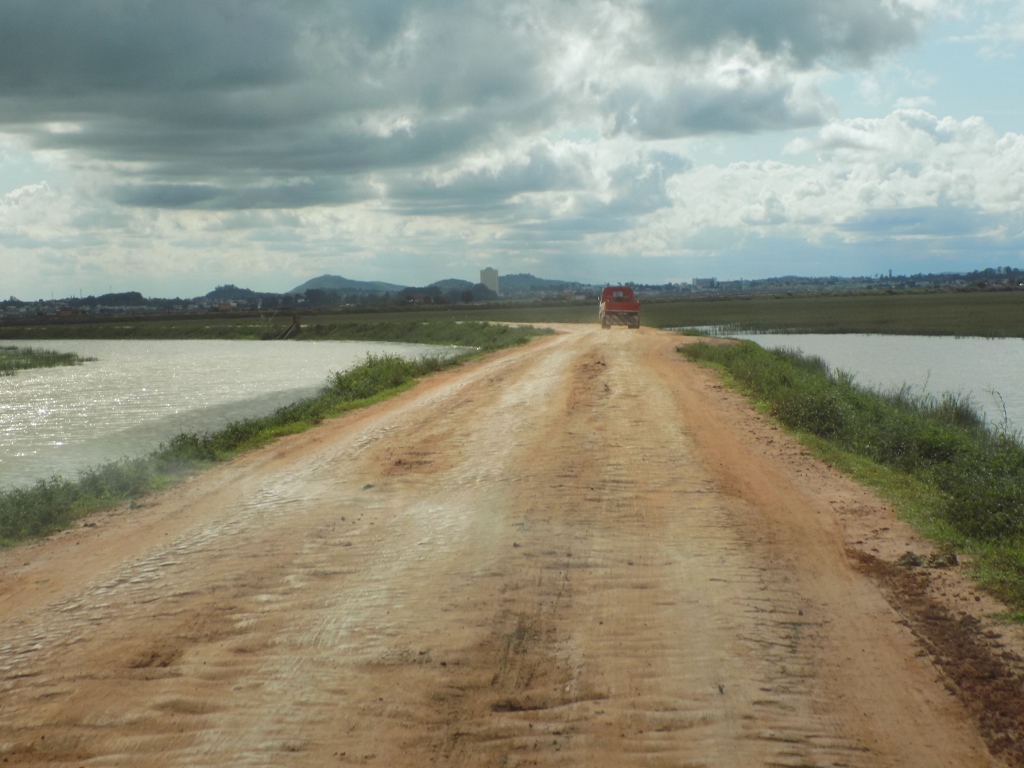 It is completely dry and stable here
It is completely dry and stable here
But, muddy parts still appeared from time to time and it was obvious that this road was used by different vehicles.
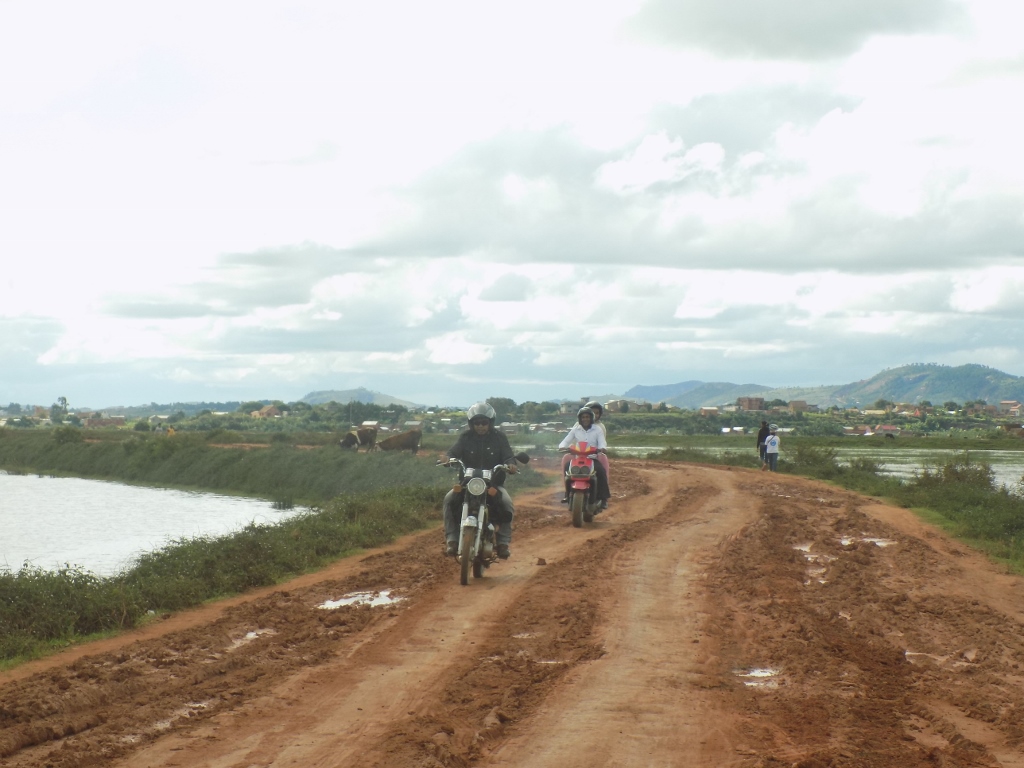 There are pedestrians and motorcyclists here as well
There are pedestrians and motorcyclists here as well
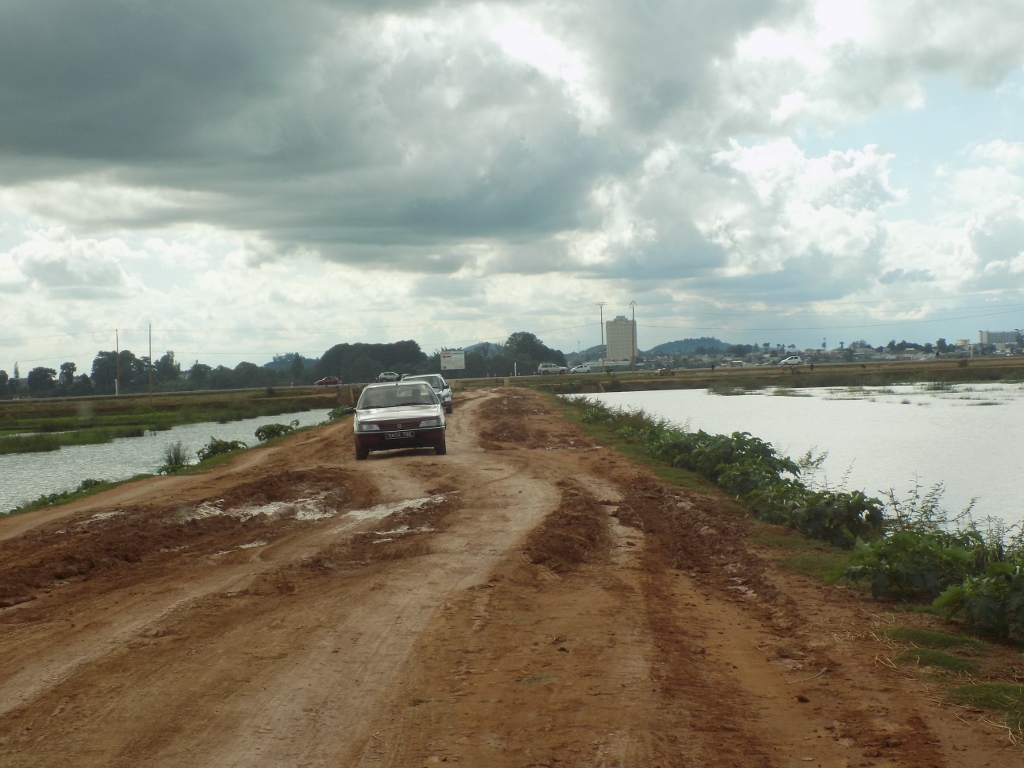 And there are also cars going in the opposite direction without knowing what is yet to come
And there are also cars going in the opposite direction without knowing what is yet to come
As I’ve mentioned before, Antananarivo spreads across a large number of hills and flat parts of the terrain, while in between I often saw bigger or smaller areas under water. In some places these were rice paddies, while as for the sections to the left and right from this embankment we were driving on I have no idea what they were for, but they certainly were not the permanent smaller lakes that exist within the city.
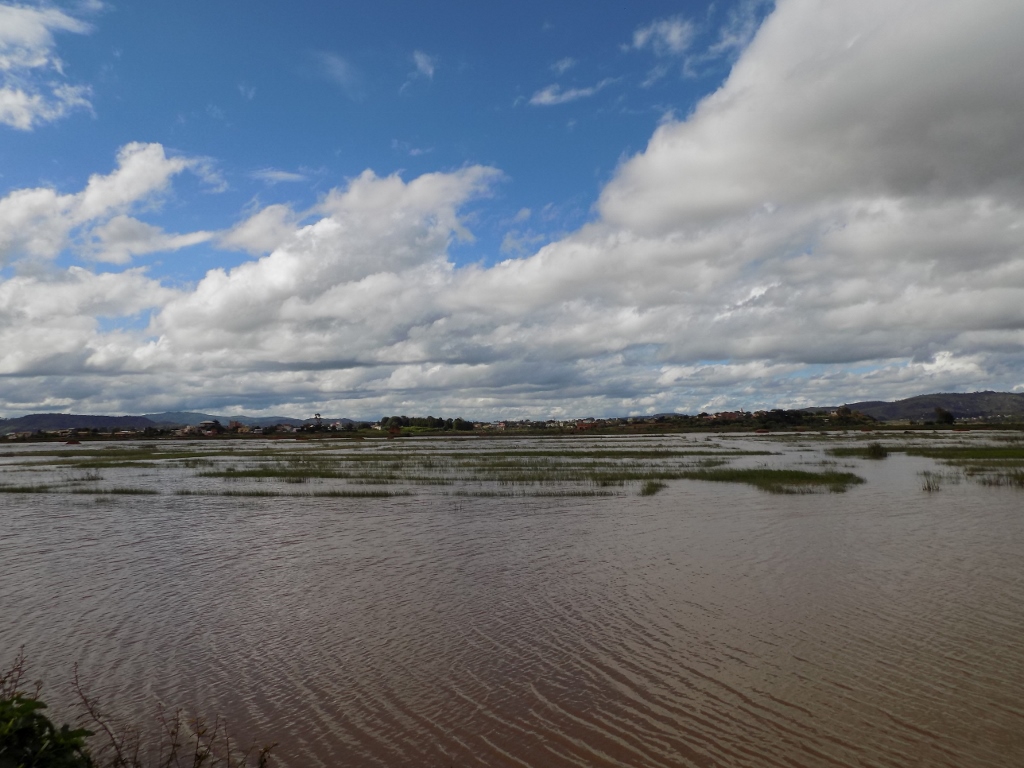 A mystic lake
A mystic lake
Since we succeeded in avoiding the traffic jams, soon we entered the central parts of the city and there at some point I could nicely see the Rova of Antananarivo. This is a royal complex of palaces and the word “rova” means fortified palace. Although there were also palaces in Ambohimanga from where we were just coming, Ambohimanga constituted primarily the spiritual centre of the Kingdom of Merina and later of the Kingdom of Madagascar. On the other hand, the Rova of Antananarivo is situated on the highest point of the originally highest of the numerous hills and this was precisely the reason for selecting this place as the venue where the home of the rulers of the Kingdom of Merina would be built already back in the 17th and the 18th centuries.
As the rulers succeeded one another through history, thus they also kept adding new buildings here and then the biggest palace was built for Queen Ranavalona I between 1839 and 1841 which was called the “Queen’s Palace.” That building was fully made out of timber and then in 1867, during the reign of Queen Ranavalona II, a stone structure was made around that building. This is precisely what can be seen in the photo below as the most outstanding edifice.
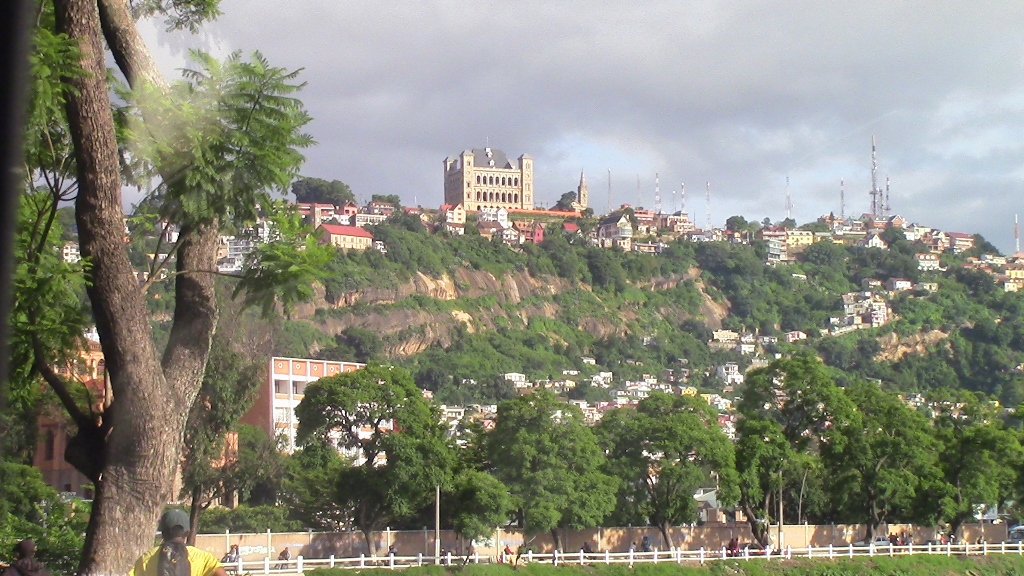 Rova of Antananarivo on the top of the hill
Rova of Antananarivo on the top of the hill
And then in 1995, there was a huge fire at the Rova and all the parts of the complex were destroyed or damaged, including the wooden part of the Queen’s Palace. (In the previous text I mentioned that the royal tombs got destroyed in that fire, too.) At the time when Sneža and I were in Antananarivo the reconstruction of this complex was still not completed.
I took the opportunity of our return to Antananarivo to film from the car the city and the streets we were driving through. In this way, one can get an impression about the general appearance of the city and not only of the buildings which foreign visitors find interesting.
Rija brought us to the hotel I had booked in Antananarivo and there, after some 15 days of driving around together, we parted with him. The renting of the car and driver was an excellent thing. Although both Sneža and I love local transport, the journey around Madagascar, as well as the entire organisation of the journey were significantly facilitated in this way. A good vehicle and a private diver are undoubtedly a more expensive option, but the quantity of the saved time, the comfort, safety and simplicity certainly fully justified our final choice.
After we had settled at our hotel, Sneža and I decided to go for an early dinner. Our partial problem lay in the fact that everybody sort of “scared” us on account of the safety situation in the capital of Madagascar. Still, the owner of the hotel recommended to us a good restaurant in the vicinity and thus Sneža and I headed there on foot. Apart from the fact that the street was extremely steep, there were no other problems. However, when we got to the restaurant we saw that it opened only at 7 pm. Luckily, not far from there we noticed a terrace of another restaurant, which turned out to be a part of a nice boutique hotel. We went there and first we had coffee on the terrace from where we had an amazing view. When we got back to Antananarivo, the Sun was still trying to get through the clouds, but in this late afternoon it shone unhindered on the slopes of the surrounding hills. But, because of the safety issues, my photo-camera was left at the hotel room.
At some point, a rather fresh wind started to blow and so we moved into the restaurant where we had a very nice dinner.
We spent the last day on Madagascar in Antananarivo. To start with, we wanted to do some sightseeing, but we also decided boldly to take the photo-camera (me) and the mobile phone (Sneža). Why am I emphasising this? Because even before this journey and also during the journey several people told me that Antananarivo was exceptionally dangerous and that one should not carry any backpack, or waist bag, or money, or any cameras/phones, since the thieves were very skilful and they tended to take EVERYTHING! When I read some more serious sources, I found out that it was a fact that there were pickpockets in Tana, but as far as I understood it, it was not at the level of any physical assaults or inflicting of injuries followed by the grabbing of things. For this reason, Sneža and I first agreed between the two of us what we were going to do and then we also consulted the exceptionally kind hostess of the hotel we were staying at and everything went fine. Thus I took a small, simple backpack which I carried in front of me. It contained my photo-camera, as well as money, and every time I wanted to take a photo, I would stand on a side, take up a good position, take the photo-camera out of the backpack, take the photo and then put the camera back in. In addition, it is very important that the visitor is “present” with their mind when visiting Antananarivo. After all, there are pickpockets all over the world, but what makes the pick-pocketing the same everywhere is the mental absence of the people who eventually become the victims. All in all, apart from some guys who in several places tried quite hard to convince us they could be our guides, the rest of the time we had absolutely no problems. But, as I’ve said, we were very concentrated and aware of what we were doing and whether somebody was hanging around us or not.
Still, before we started with our sightseeing, I took some photos of the surroundings from the window of our hotel room. As the following photo shows, there were many buildings in our neighbourhood, as well as a small open market.
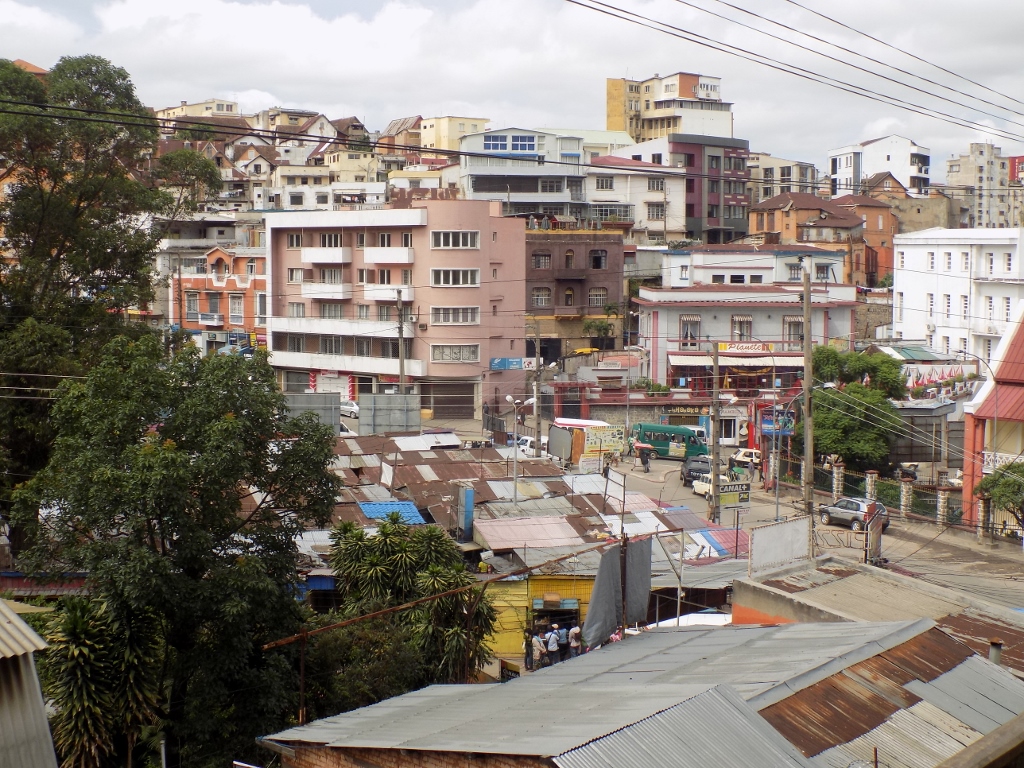 Surroundings of our hotel
Surroundings of our hotel
A very neat thing about our hotel was that right there in the street in front of it there was a sort of taxi station. So, we took a taxi and went to the highest point in the old part of the city. That was, of course, the Rova.
As I’ve said, this complex is still not open for visits. On the first day of our stay on Madagascar, we came here with Rija and then some guys wanted to be our “guides,” but the ticket office clearly displayed that tickets were not on sale until further notice. This time we did not even go to the ticket kiosk, but I took a few photos of the Queen’s palace, as well as the entrance where it was possible to see a large bronze eagle as the symbol of the military might and a phallus as the symbol of circumcision and consequently of the nobility.
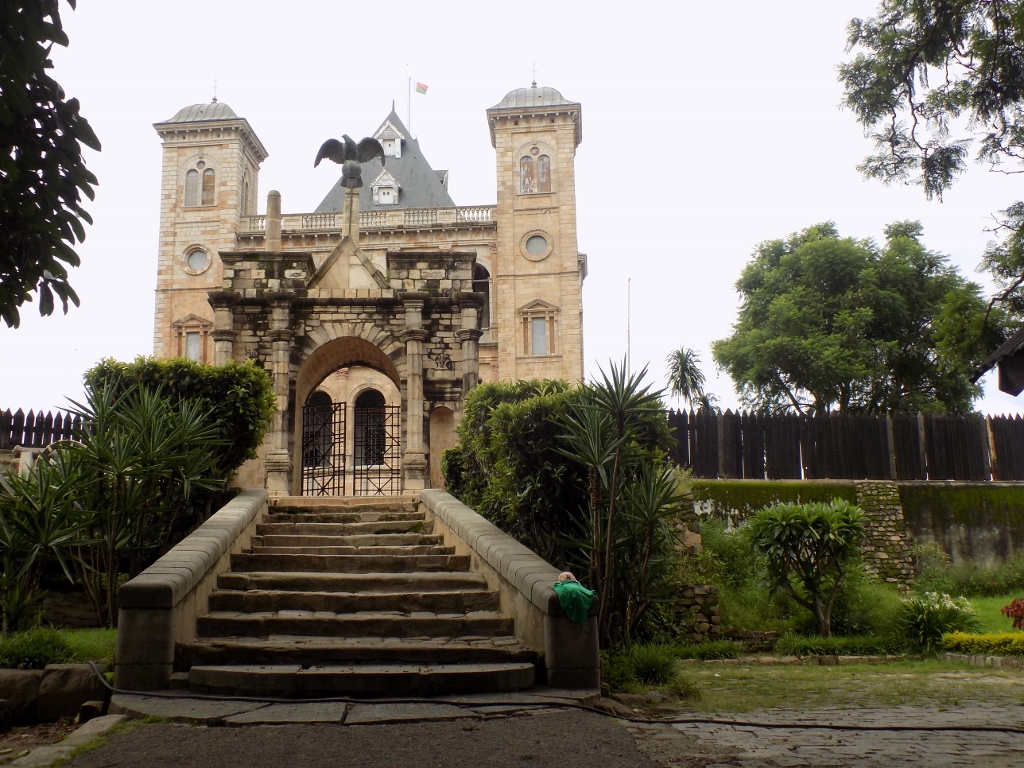 Rova of Antananarivo
Rova of Antananarivo
After this, we simply continued on foot down the hill along the street. After a couple of hundred metres, on the right-hand side, there is a wall and on the wall a long bas-relief from 1940 showing the history of Madagascar.
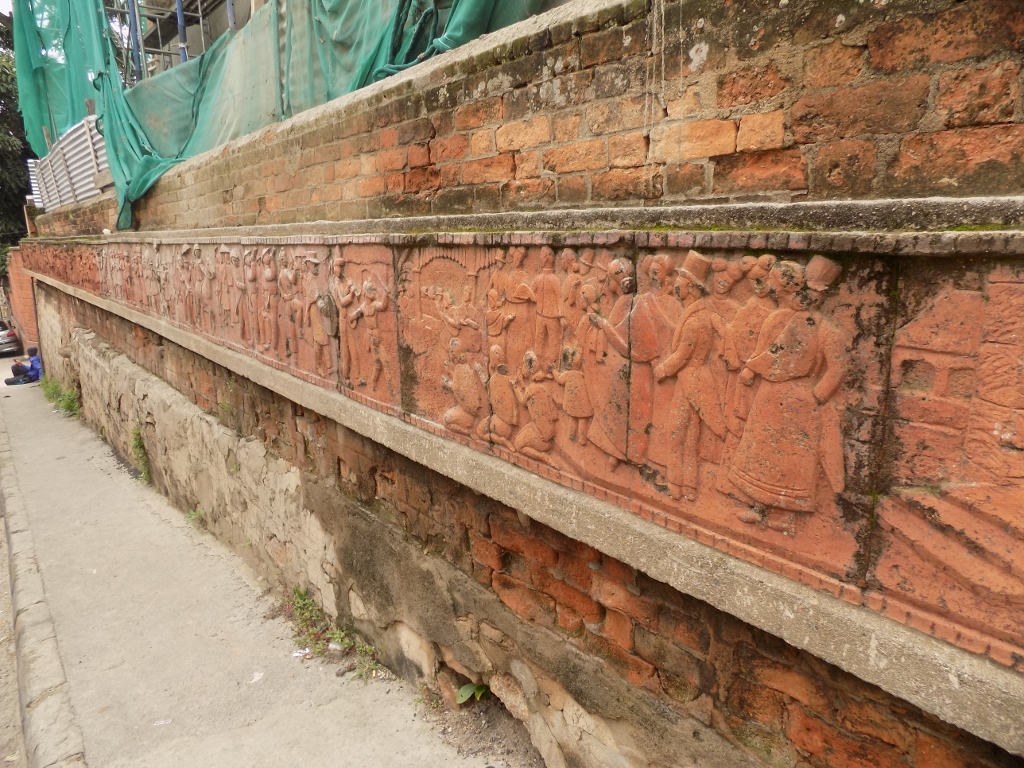 Bas-relief by the pavement
Bas-relief by the pavement

Quite close to this bas-relief, we came across a building for which I established later that it was a Court of Justice from 1881. In this place there used to be a Court of Ambatondrafandrana already at the time of the reign of King Andrianampoinimerina, but this concrete building in the shape of a Greek temple was built later.
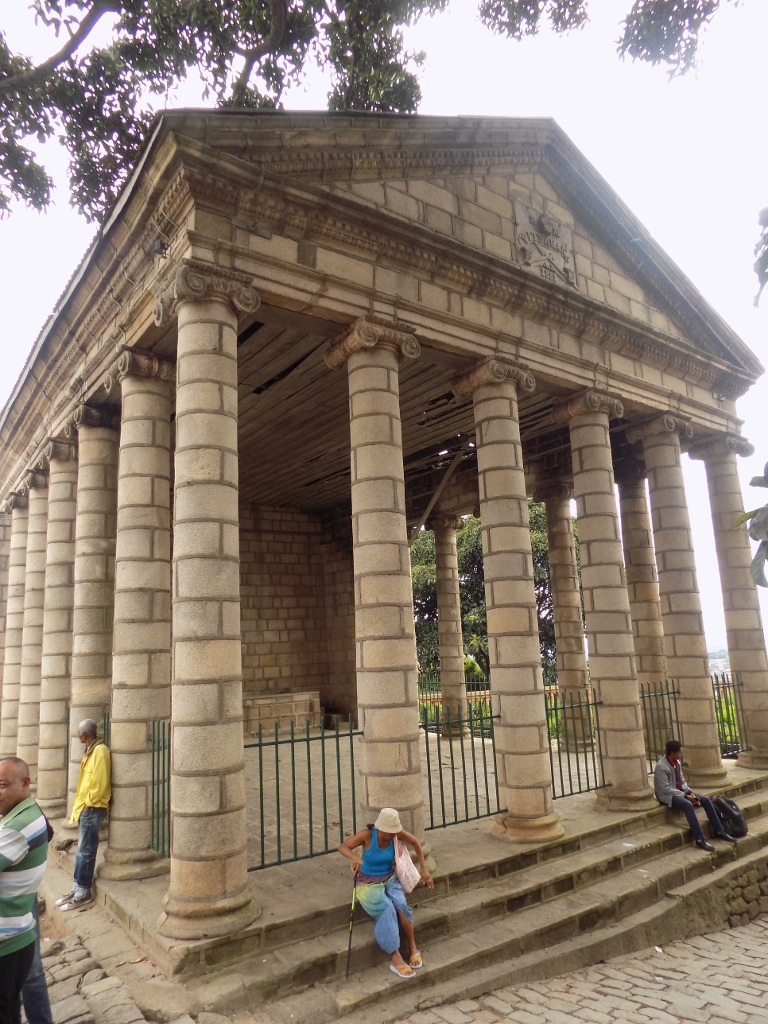 Court of Justice
Court of Justice
At the same time I took the opportunity that there were no houses on the other side of the street and hence there was a very nice view at the flat parts of the city.
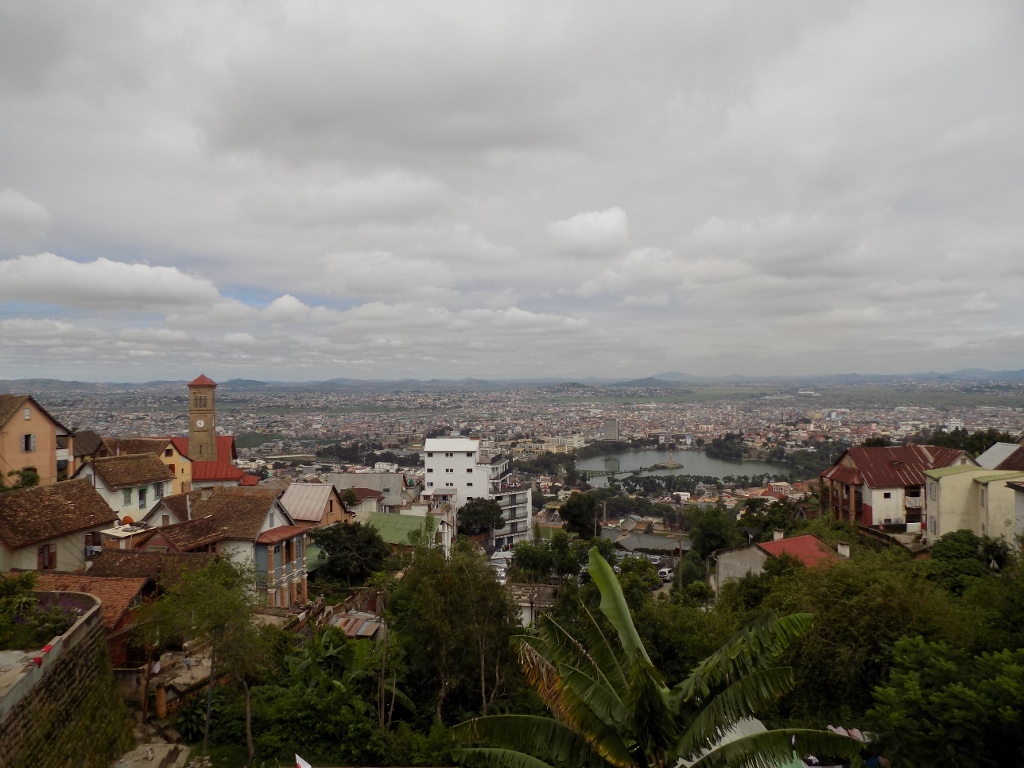 View at Antananarivo
View at Antananarivo
One of the landmarks in Tana is Anosy Lake (Lac Anosy) on which there is the Monument to the Dead in the form of a golden angel which the French erected honouring those perished in WWI.
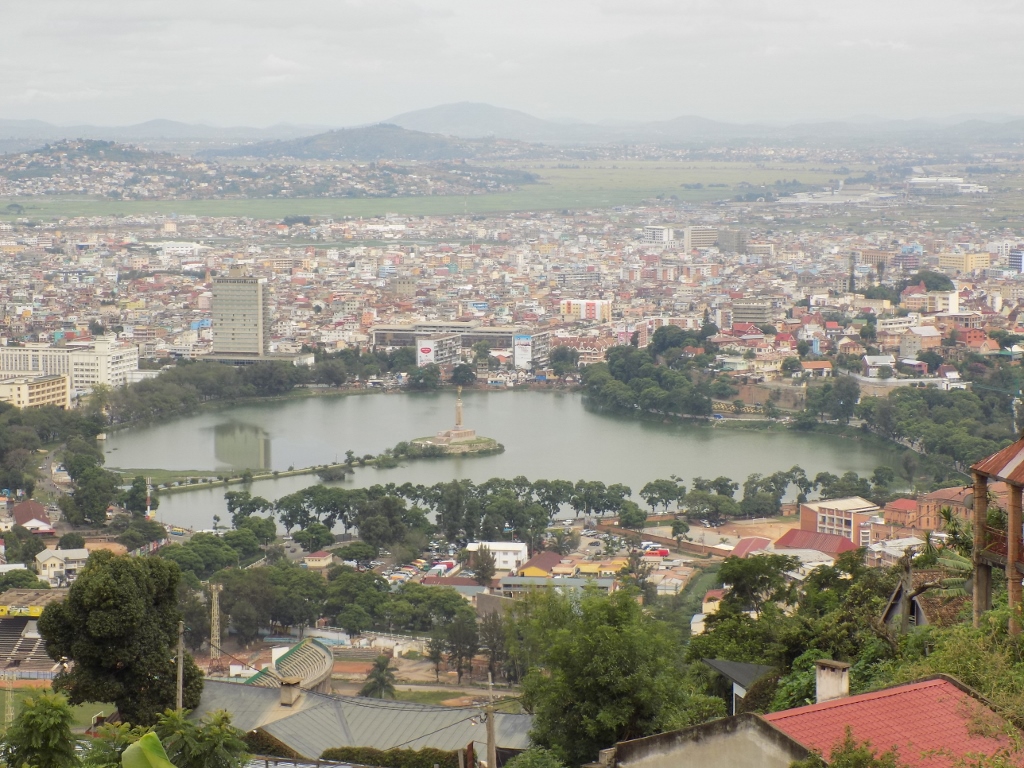 Anosy Lake
Anosy Lake
Soon we came to the Andafivaratra Museum which is located in the palace that used to be the home of Prime Minister Rainilaiarivony. That’s the 19th century prime minister who married three queens in a row and who actually ruled on their behalf. Nowadays it houses a rather modest museum, but it was certainly worth the visit.
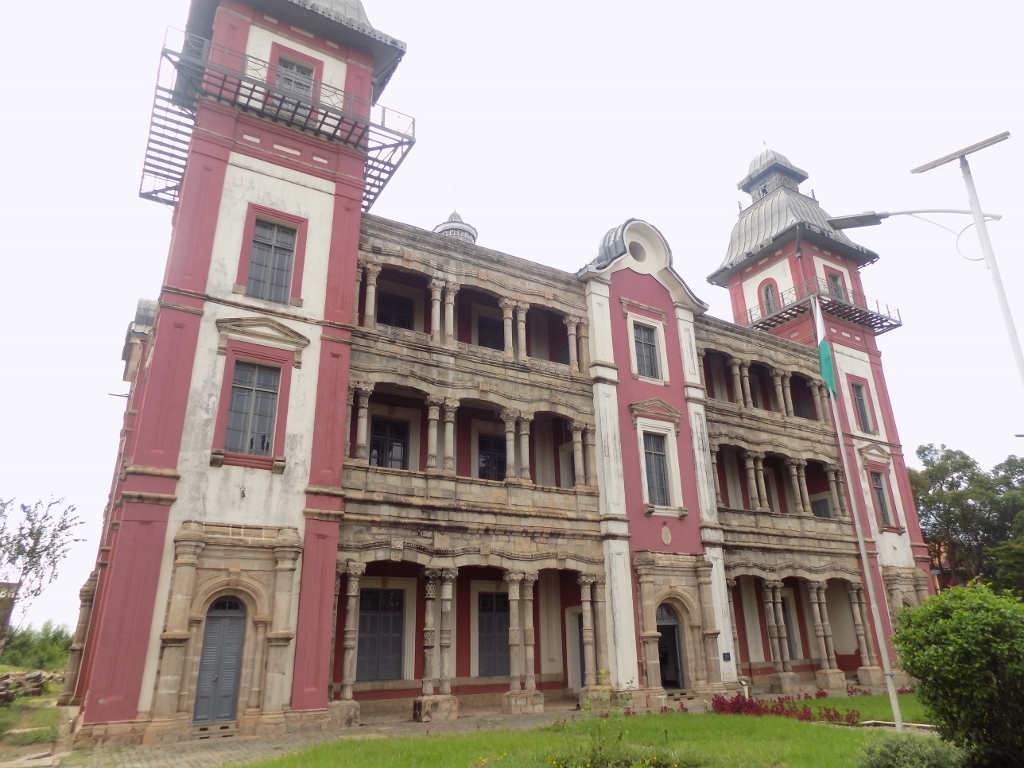 Andafivaratra Museum
Andafivaratra Museum
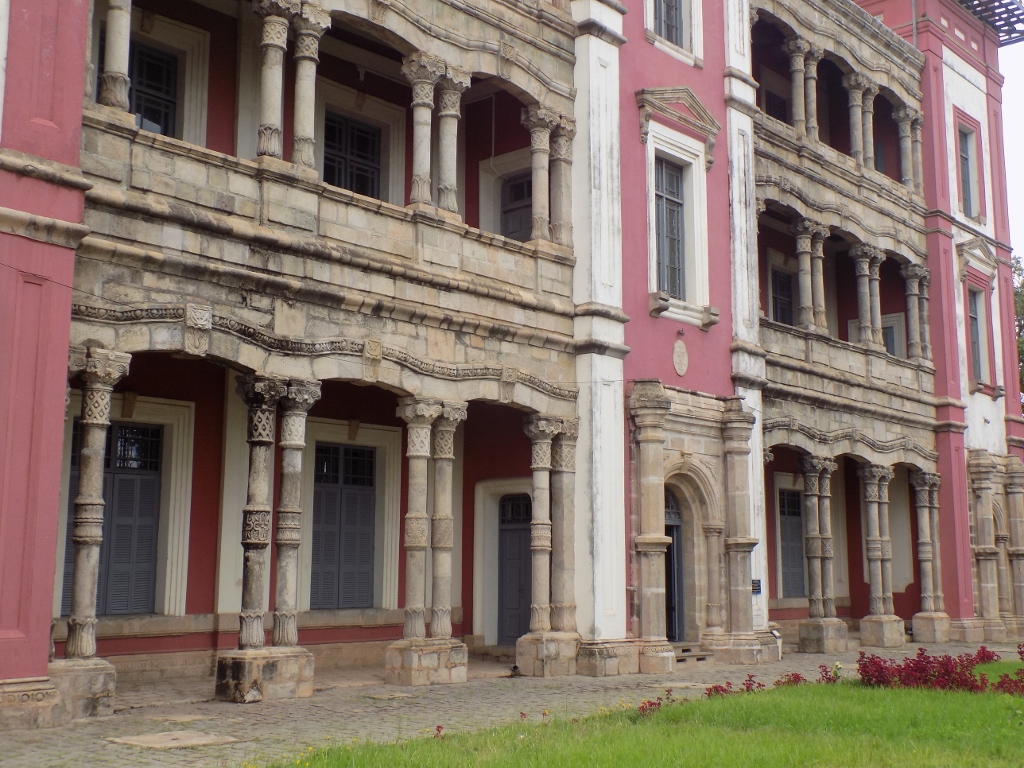 Andafivaratra Museum
Andafivaratra Museum
And then we walked to the Tsarasaotra Park where we came across a throng of people. It was Sunday morning and there was a large Anglican church beside the park, so a lot of people came there to attend the mass. We went along the other side of the green area, since that was the way of our visiting route, but it was interesting to see laundry that was arranged over the bushes of that public park and left there to dry.
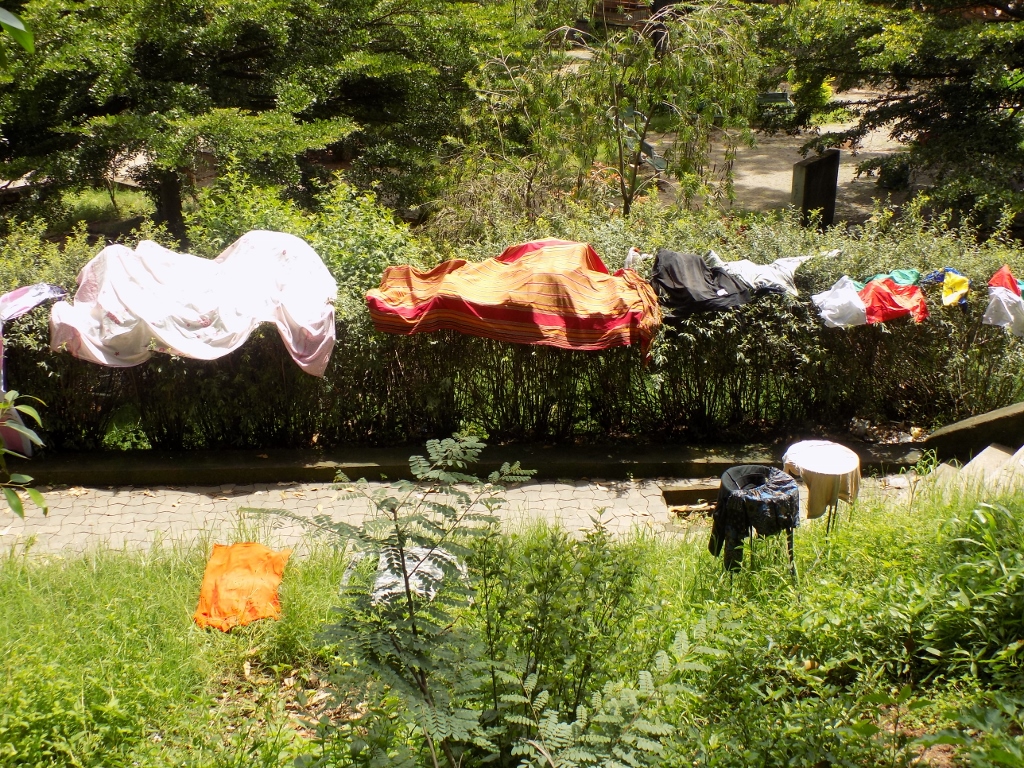 Drying of laundry in the park
Drying of laundry in the park
The next interesting thing during our sightseeing walk was the House of Jean Laborde, the French engineer who is said to have been the lover of the extremely unpleasant Queen Ranavalona I. Later, this house was the place of the first French consulate on Madagascar.
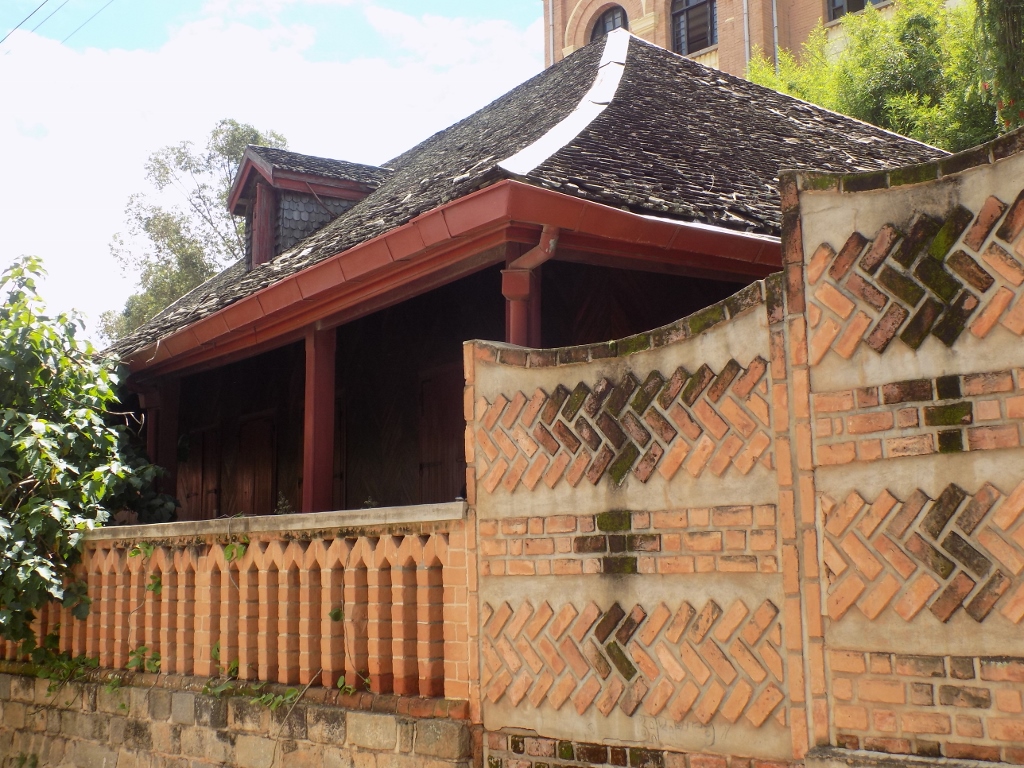 Jean Laborde’s House
Jean Laborde’s House
Not far from this house there is the Immaculate Conception Cathedral which was built in the second half of the 19th century on the spot from which Christian martyrs were thrown down the cliff at the orders of the already several times mentioned Queen Ranavalona I.
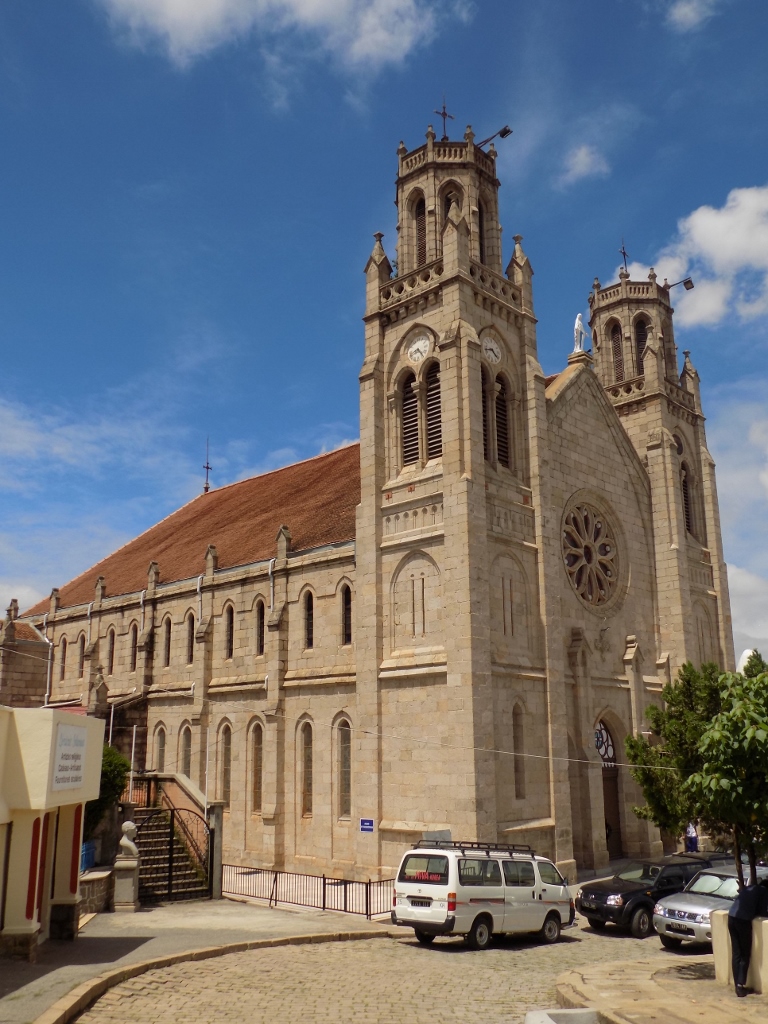 Immaculate Conception Cathedral
Immaculate Conception Cathedral
On this occasion, there was an ongoing Sunday mass at the cathedral.
Not far from there, we had again a very pretty view at the lower sections of the city and Anosy Lake, as well as some parts of the Upper Town.
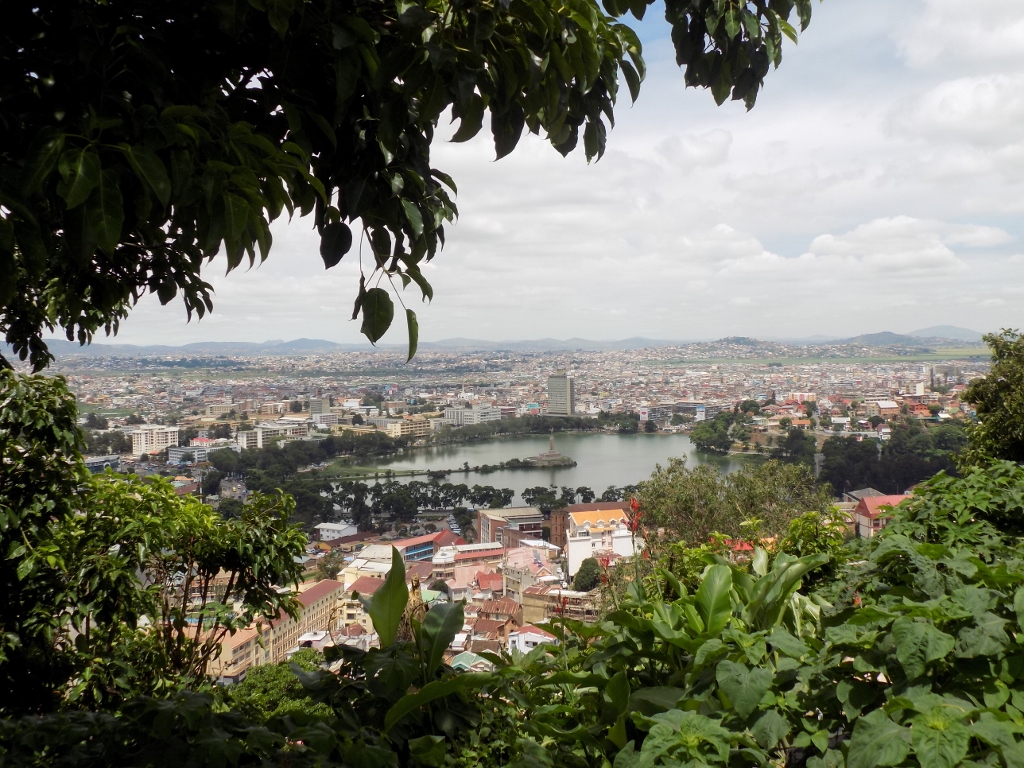 Anosy Lake
Anosy Lake
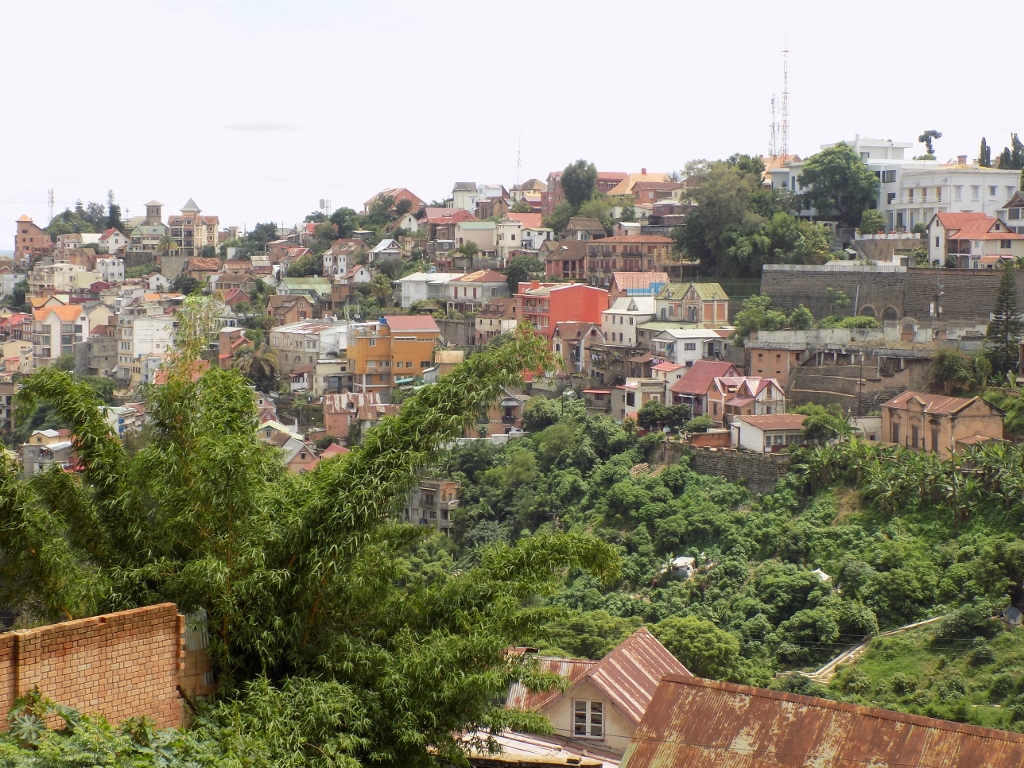 Residential parts of the Upper Town
Residential parts of the Upper Town
After this we headed down a relatively steep street and there we had a longer section that we needed to cover on foot. Still, it was interesting.
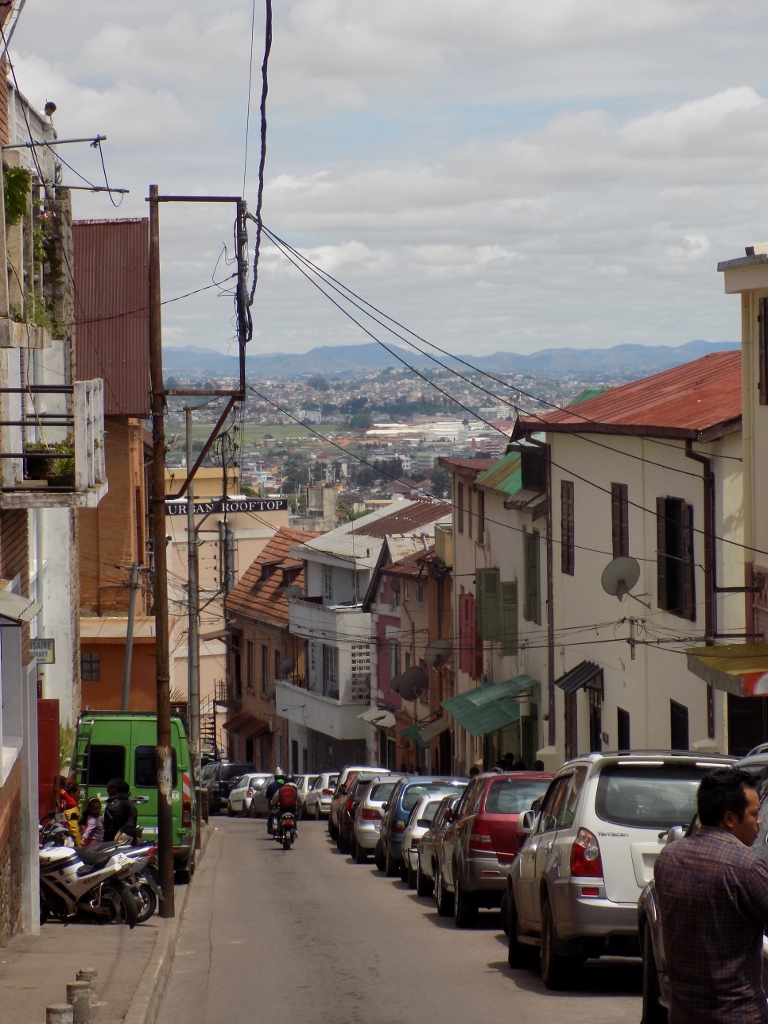 Going down the steep streets of the Upper Town
Going down the steep streets of the Upper Town
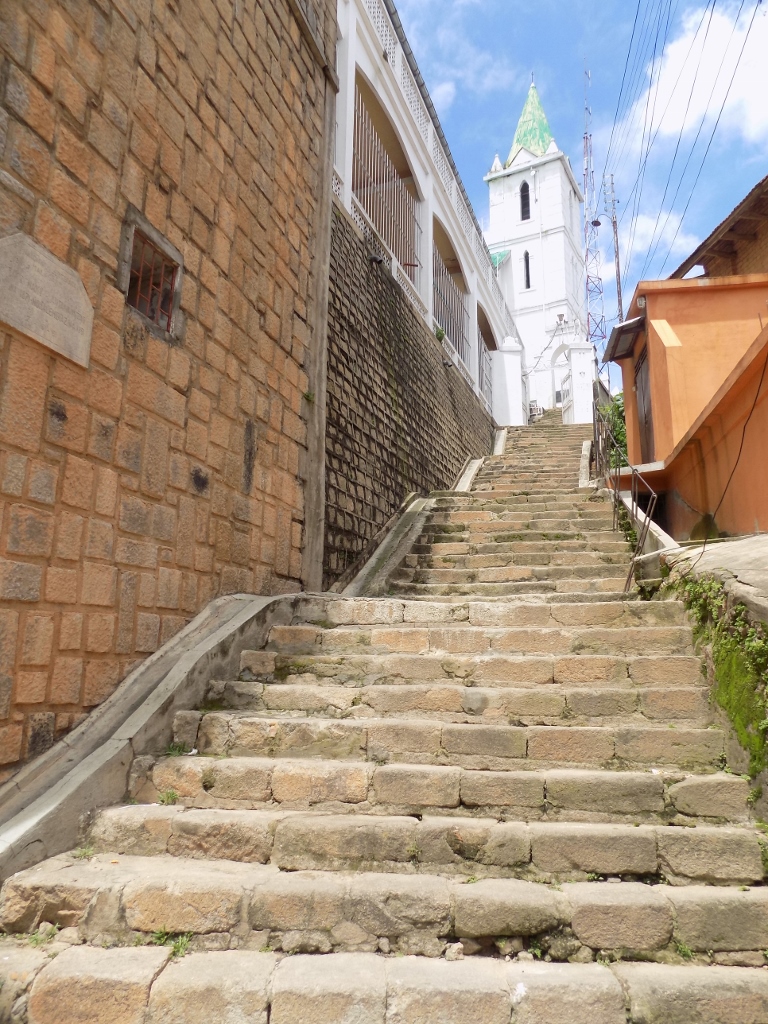 Side streets and stairwells are also steep
Side streets and stairwells are also steep
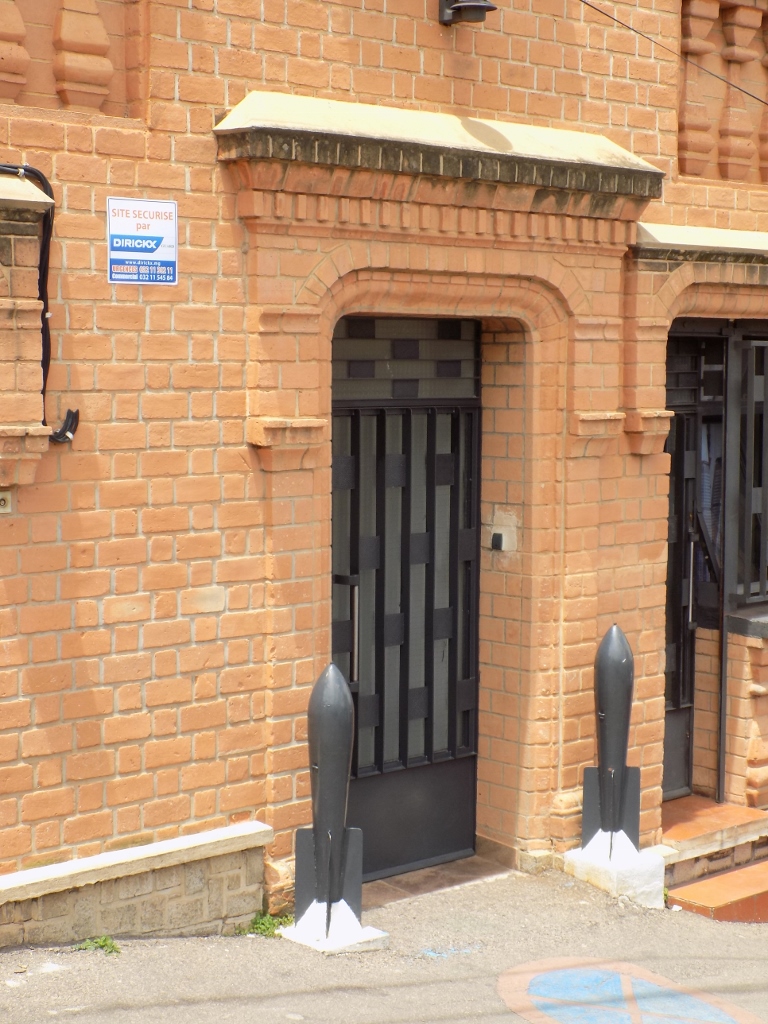 Interesting decoration of the entrance door
Interesting decoration of the entrance door
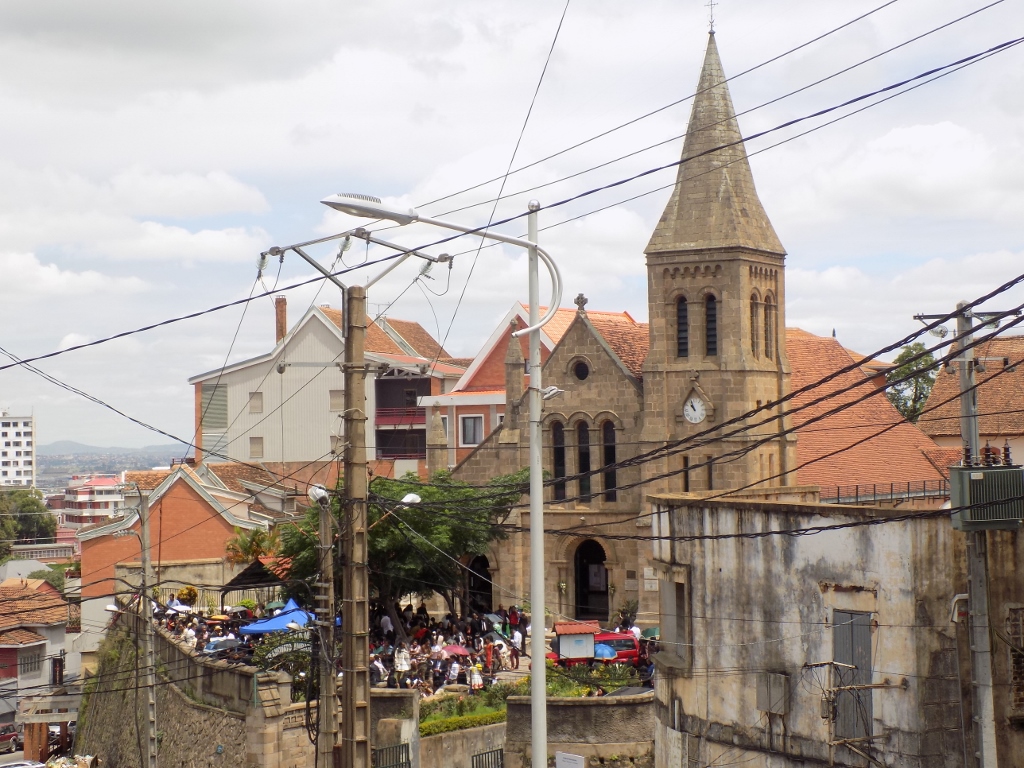 As it was Sunday, it was quite crowded in front of every church
As it was Sunday, it was quite crowded in front of every church
And then we came to the Presidential Palace. This pretty building from the 19th century got this function in 1975 and although a new presidential palace was built in another place in 1991, this one here still constitutes the official residence of the presidents of Madagascar.
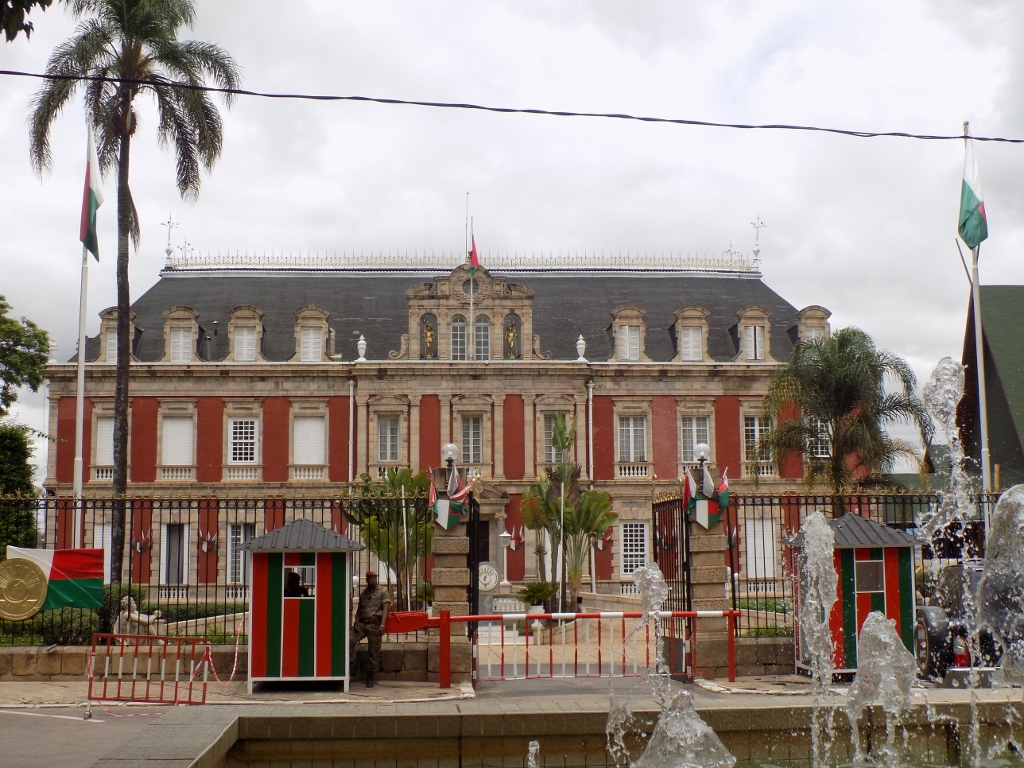 Presidential Palace
Presidential Palace
By the time we got here we were already quite tired. The walking itself was not difficult or tiring at all, but it was rather hot and humid, and that exhausted us. For this reason, we sat at the terrace of a nice restaurant-pastry shop and ate something light and got refreshed there.
Following the good rest, we went to the park at the Independence Square where there was a tourist information office. A little too late for us, but we still stopped by and took a map of Antananarivo each as a souvenir.
Then, from that square we started to go down again, this time in the direction of the Analakeli market. This is the biggest market in Antananarivo, but on the basis of the information we had, we thought it would not be quite safe and prudent for the two of us to walk around there.
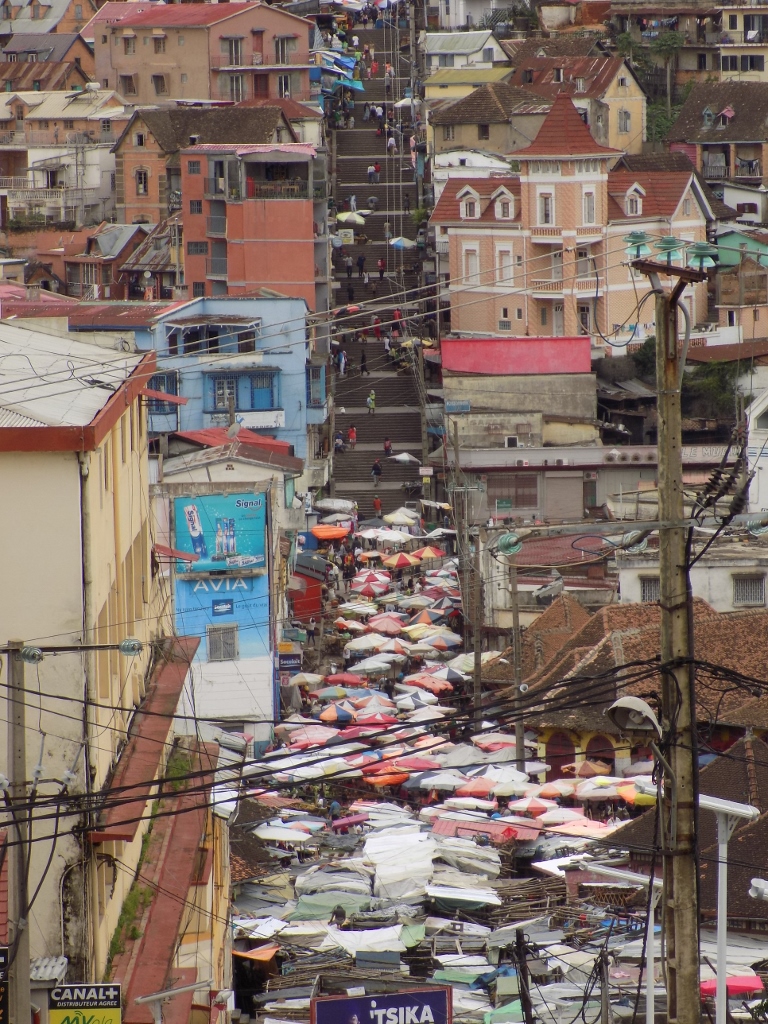 View at a part of the market from the direction of the Independence Square
View at a part of the market from the direction of the Independence Square
That is why we just went down to a big street where we caught a taxi. Namely, it was Sunday, early afternoon, and some shops were still open while the two of us still needed some small items. Thus we went to a larger shopping mall and there we finished with all that we required.
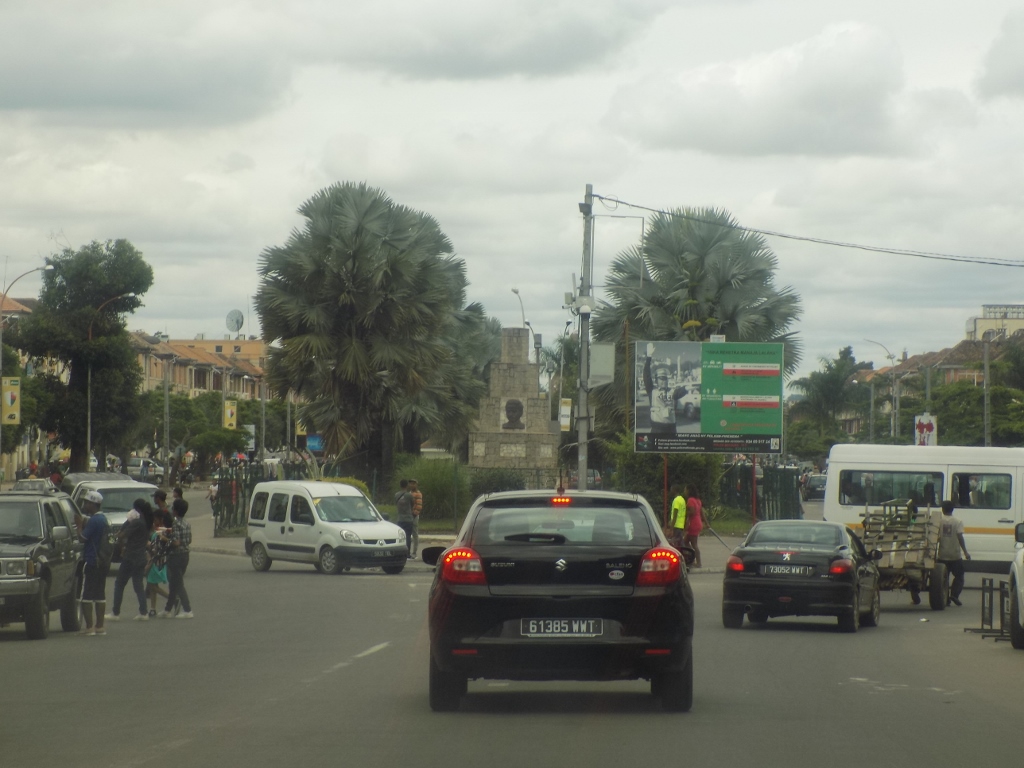 A little bit more of driving along the streets of Tana
A little bit more of driving along the streets of Tana
Then we took a taxi again and returned to the part of the city around the Presidential Palace where we continued with our stroll, but now in a different direction. Since the map we had did not seem quite clear to us, we stopped at a nearby hotel where we wanted to make inquiries, but we got quite a surprise when we entered the courtyard of the hotel. There we saw a very nice and interesting motor pool.
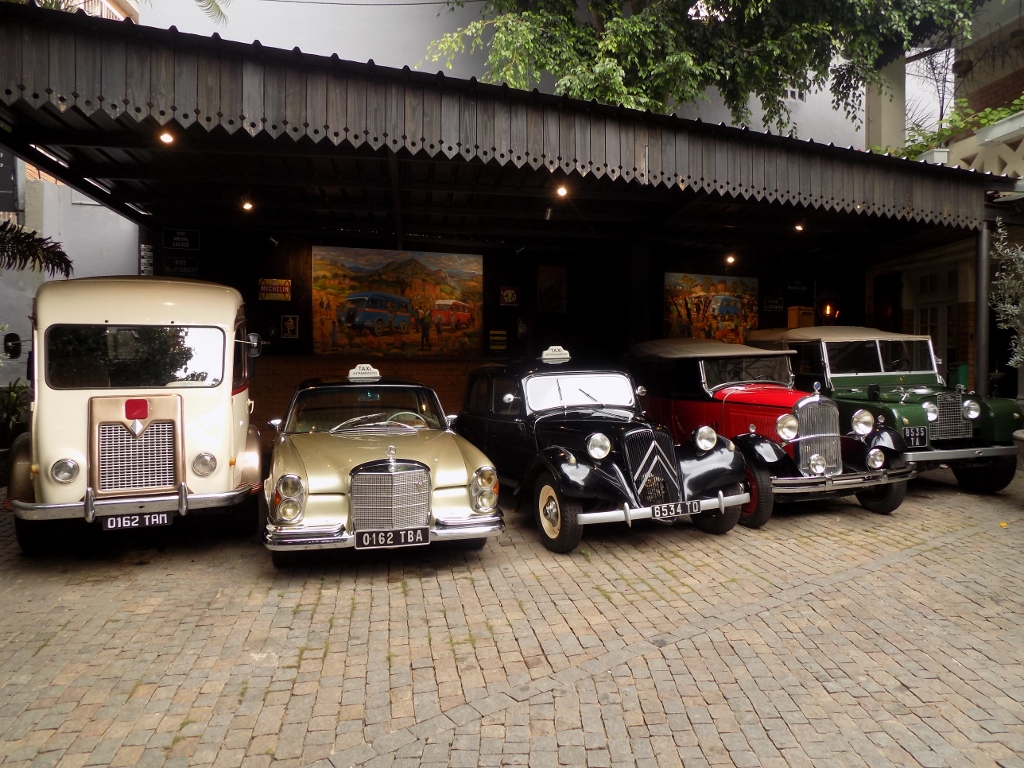 Motor pool of one of Tana’s hotels
Motor pool of one of Tana’s hotels
In addition to allowing us to take photos of their motor pool, the kind employees of the hotel also gave us clear instructions as to how to proceed. Thus we went down the hill and reached the shores of Anosy Lake.
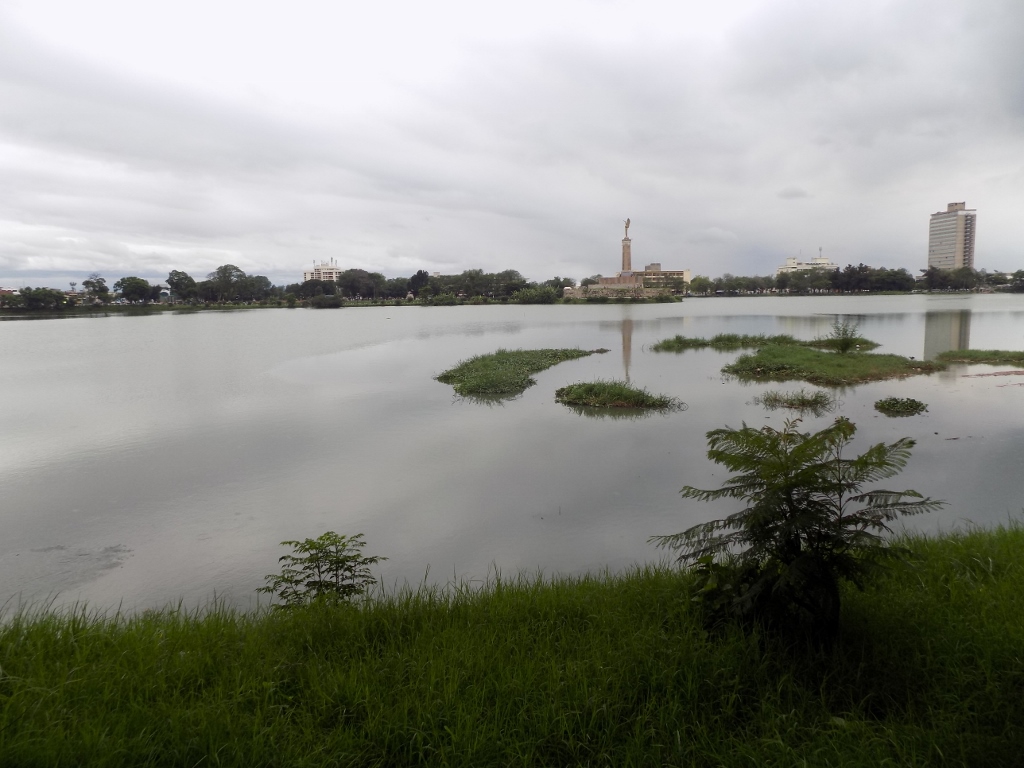 Anosy Lake
Anosy Lake
We did not stay here for too long as it was already afternoon and we still had to pack up. Later we went for dinner again at the same place as the evening before, because the restaurant we originally wanted to go to was closed again because it was Sunday. Obviously, it was not meant to be.
Rather late in the evening we took a taxi to the airport from which our flight to Europe departed after midnight. With this, our stay in Madagascar was over and here is a reminder of the places we went to.
So, what can I say as a closure? I had Madagascar on mind for years and for a completely unknown reason I wanted to go there dearly. Before the journey I was full of trepidation and during and after the journey... I think that in my entire life I have not used the word “exhilarated” as many times as I used it when talking about how I felt during the journey and after my return home. Madagascar is a fantastically beautiful country and my travelling around it has certainly created one of the most impressive memories in my mind.
Today, a much larger number of people have a personal “contact” with Madagascar without even knowing this. Here I’m thinking of a simple and yet pretty plant that is often grown in other parts of the world as decorative one. This is the bright eyes or Madagascar periwinkle (Catharanthus roseus) which is endemic on Madagascar.
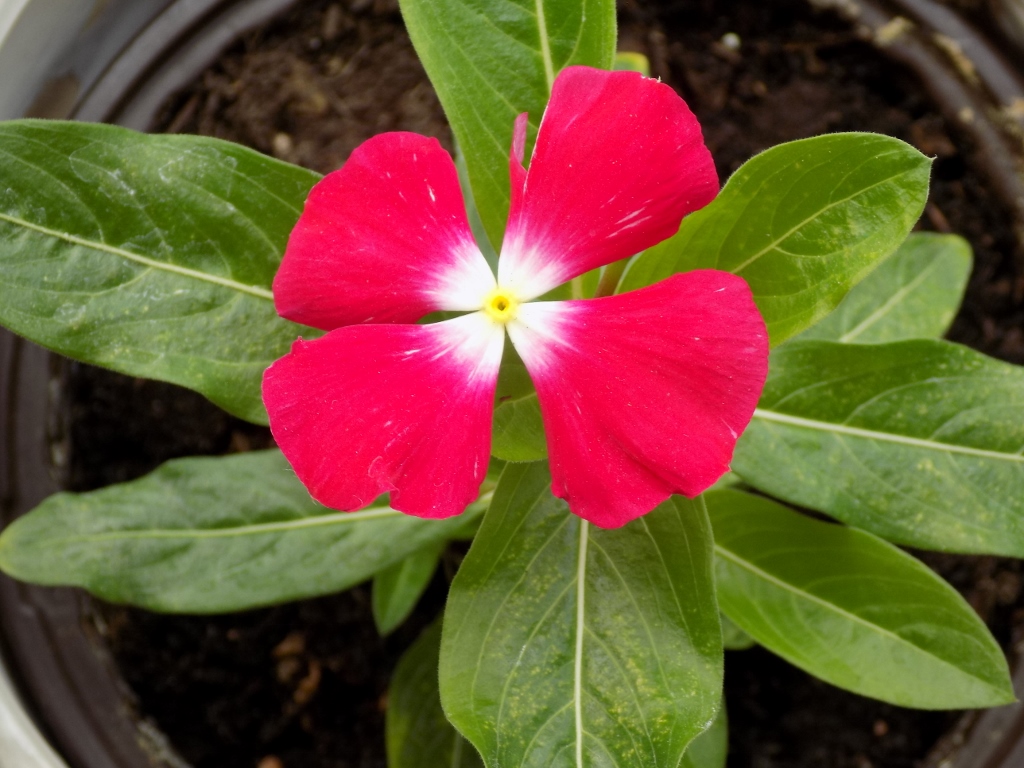 Madagascar periwinkle on my window sill
Madagascar periwinkle on my window sill
For those to whom this is not enough to transfer with their thoughts to this stunning island, here is a short reminder of the Madagascar panoramas. Perhaps this will inspire somebody to head that way.